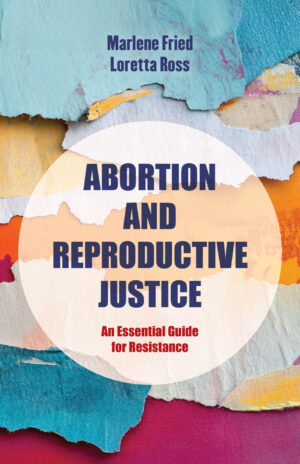Reproductive Freedom and Bodily Autonomy for All
By Marlene Fried and Loretta Ross, authors of Abortion and Reproductive Justice: An Essential Guide for Resistance
We decided to write this book in 2018. Just two years into Trump’s first presidency, the opposition to reproductive health, rights, and justice was already emboldened, and while political alarm bells had been ringing for a long time, our urgency quotient went through the roof. The forces on the Right that he unleashed were terrifying then; even more so now. And we wanted to explain what appeared to be a dramatic disconnect: many of the people who oppose abortion bans voted for Trump and other candidates who not only support restrictions on abortion, but who are determined to destroy all the human rights that comprise reproductive justice: the right not to have a child; the right to have a child; the right to parent in safety and dignity; and the right to bodily autonomy.

Trump Supreme Court appointees, staunch opponents of abortion, provided the votes for the 2022 decision in Dobbs v. Jackson Women’s Health Organization, which overturned Roe v. Wade and removed all federal constitutional protections for abortion. Since Dobbs, four women have died because they were denied timely and necessary lifesaving care by hospitals and doctors who felt constrained by their state’s laws. All four deaths were preventable. In 2023, Human Rights Watch reported, “Women and girls in need of reproductive healthcare are being met with systematic refusals, onerous financial burdens, stigma, fear of violence, and criminalization. Thousands are being forced to remain pregnant against their will. Infant mortality has increased, and contraceptive services have declined in states with bans." Those monitoring the impact of Dobbs warn of more and worse to come.
Republican-controlled state legislatures quickly took up the Trump legislative baton. As of November 2024, twenty-one states ban or restrict abortion earlier in pregnancy than under Roe. These laws disproportionately impact vulnerable populations who face compound barriers from multiple oppressions. Nearly half of all states also ban gender-affirming care. As with abortion, these bans force people to travel for care, search for alternatives, or forgo it all together. A few high profile examples from his second term reveal the thorough-going nature of Trump's agenda for reproduction:pardons for anti-abortionists found guilty of assaulting and injuring abortion clinic staff; directing the Department of Justice to only enforce the Freedom of Access to Clinic Entrances (FACE) Act in "extraordinary cases"; continued attacks on medication abortion and telehealth; efforts to establish fetal personhood in law which would ban abortion in every state; rescinding the Emergency Medical Treatment & Labor Act (EMTALA) that requires hospitals to provide life-saving care, including abortion, to pregnant women suffering medical emergencies; reinstating the Global Gag Rule; and de-funding Planned Parenthood through the "Big, Beautiful Bill" that slashes Medicaid and makes huge cuts to SNAP (Supplemental Nutrition Assistance Program) and other programs low-income families rely on just to get by.
But there has also been an outpouring of support for abortion rights and widespread resistance to the bans, certainly in reliably blue states, but also in those that are more conservative, such as Kansas. In the 2022 midterm elections, advocates mobilized voters to reject bans and to expand state constitutional protections for abortion, and successfully staved off a predicted electoral “red wave." Even with sweeping Republican electoral victories in 2024, support for abortion rights remained strong. In the majority of cases, when the issue is put directly to the voters, their support for abortion rights prevails.
In this book, we use the reproductive justice (RJ) lens to disrupt old strategies and understandings, to critically analyze abortion politics of the past, and to make sense of the present. Through that lens, we see that abortion is part of a wider landscape, one deeply rooted in the systems of oppression that define power and which structure people's lives in this country. Deciding which bodies and therefore whose reproduction is valuable has been a consistent theme in U.S. history. The book shows how racism, white supremacy, patriarchy, xenophobia, population control, and eugenics have been integral to these decisions.
The history we tell is not simply a tale of oppression. Throughout the book, we turn to the stories of individual and collective resistance in order to illuminate reproductive justice thinking and practice. We are deeply committed to abortion rights, but we are also convinced that this pivot to a reproductive justice approach is the only way to secure reproductive freedom and bodily autonomy for all people. As we discuss, the breadth of the analysis has the potential to transcend political divisions and to build a more expansive movement. However, neither reproductive justice itself nor this approach to abortion is widely known and accepted, even among many reproductive rights advocates. Those outside the movement are even less familiar with it. We want our book to bring greater visibility to this way of thinking and acting.
Learn more about Abortion and Reproductive Justice.

